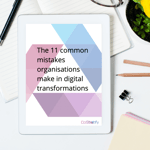Has your Digital Transformation got off on the right track?
If you’re not sure why it’s so hard to get digital transformation off the ground in your organisation, this might be what’s going on…
We’ve been helping clients for a number of years now to get started with their digital transformations, and we know the importance of good strategy. One key area in our method when engaging with clients is looking at what ICT challenges they are currently facing. Not just to help determine where change needs to happen most urgently, but to also guide clients' understanding of how these struggles manifest themselves within an organisation and ultimately how to sidestep them to ensure success!
By taking an objective view as to where, when, how, and why these blockers appear, it is a key area to enable clients to be successful with their transformation. Here are some key areas we’ve seen customers struggle with over the years and if you’re struggling with these too… the steps to think about getting through them:
- Capacity headroom to change - The number one issue for a lot of ICT departments, we find, is the capacity to think about or perform change whilst in the day-to-day delivery mode. Fighting against burning platforms and keeping up with numerous incidents or requests for small change often seeps focus away from more transformational projects and inhibits teams from thinking about and performing strategic change that aligns with what the business needs.
2. Technical debt or legacy - End-of-life infrastructure, legacy applications, and out-of-date end-user technologies causing numerous incidents for ICT to deal with, leading to a poor experience for end-users. Difficulty in planning for change and not building change into the longer-term ICT strategy and aligning to the needs of what the organisation wants can lead to putting off the refresh to the point where only a huge project fixes the issue, causing lots of disruption to end-users and masses of cost that the organisation must invest just to get the service experience back to acceptable levels.
3. Lack of budget - Throughout the clients we engage with, we find a lack of budget for resources as one of the top reasons for the inability to start to digitally transform. We find there is a shortfall in information around existing service costs and awareness of how changing service approaches, applications or technology components can impact the overall cost of ICT to the wider organisation. This information gap then limits the ability for ICT to be able to "pitch" to senior executives outside of ICT for more funds, showing the return on investment that a wide-scale change may provide.
These 3 examples can be difficult to fix and it's unlikely there is one solution that will fix all of the issues we've outlined here. However, we strongly recommend looking at forming a 3 year fully costed digital strategy that enables you to:
- Realign ICT services to the needs of the organisation, forming a roadmap that aligns to what technology services are delivered from ICT and how best consumers of ICT services wish to engage with the technology, applications, and services they need to perform their roles.
- Make the financial case for strategic change to bring in backfill resources, 3rd party expertise, or new hires to release pressure and ring-fence people specifically to change.
- Look at the wider impact of change and understand what additional resources are needed to reduce blockers, reducing the likelihood of needing additional funds or time to deliver the change that your organisation needs.
- Fully cost the current service and align costs to services, not just provided from ICT, but also to services provided by the wider organisation through cost allocation and enterprise architecture techniques.
- Align service, business analysis, project management office, and technical governance processes and procedures. Put the right tools in place to surface the right data at the right time to senior management so the right decisions can be made at the right time throughout strategy delivery
At CoStratify we realise it's not always easy to see the issues outlined above or understand the causes of them. It then can be even more difficult to put a plan in place to fix the core issues that ICT are having and align these strategically with what the wider organisation wants from ICT.
At CoStratify we help clients understand and fix the core issues within ICT. Our Roadmap service provides an excellent framework for this, as we know how to navigate each new issue that comes up on the path of change. If you're struggling in your quest towards alignment between what different stakeholders want from technology & digital strategies within your organisations and how this impacts change, then CoStratify can definitely help!







